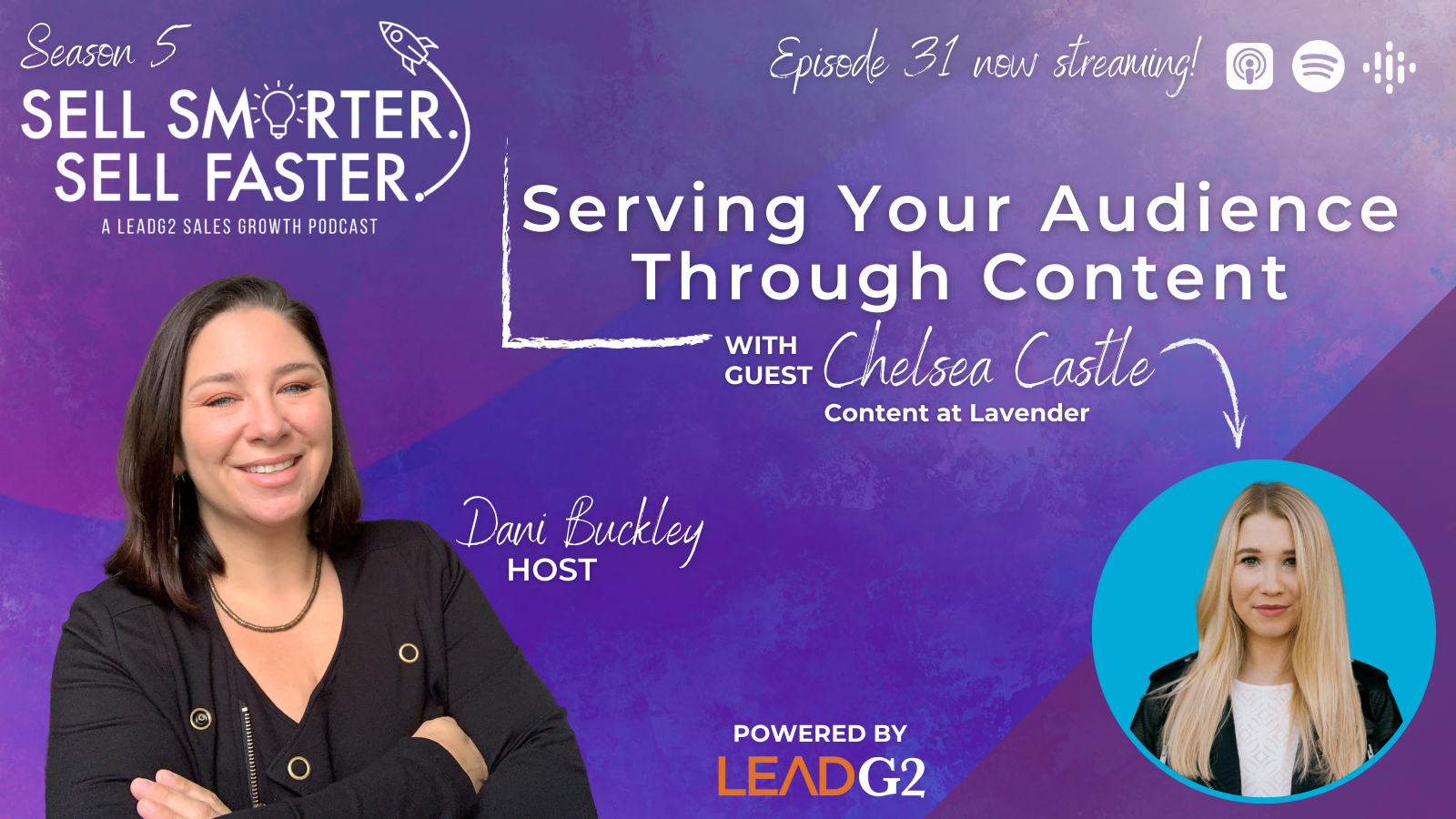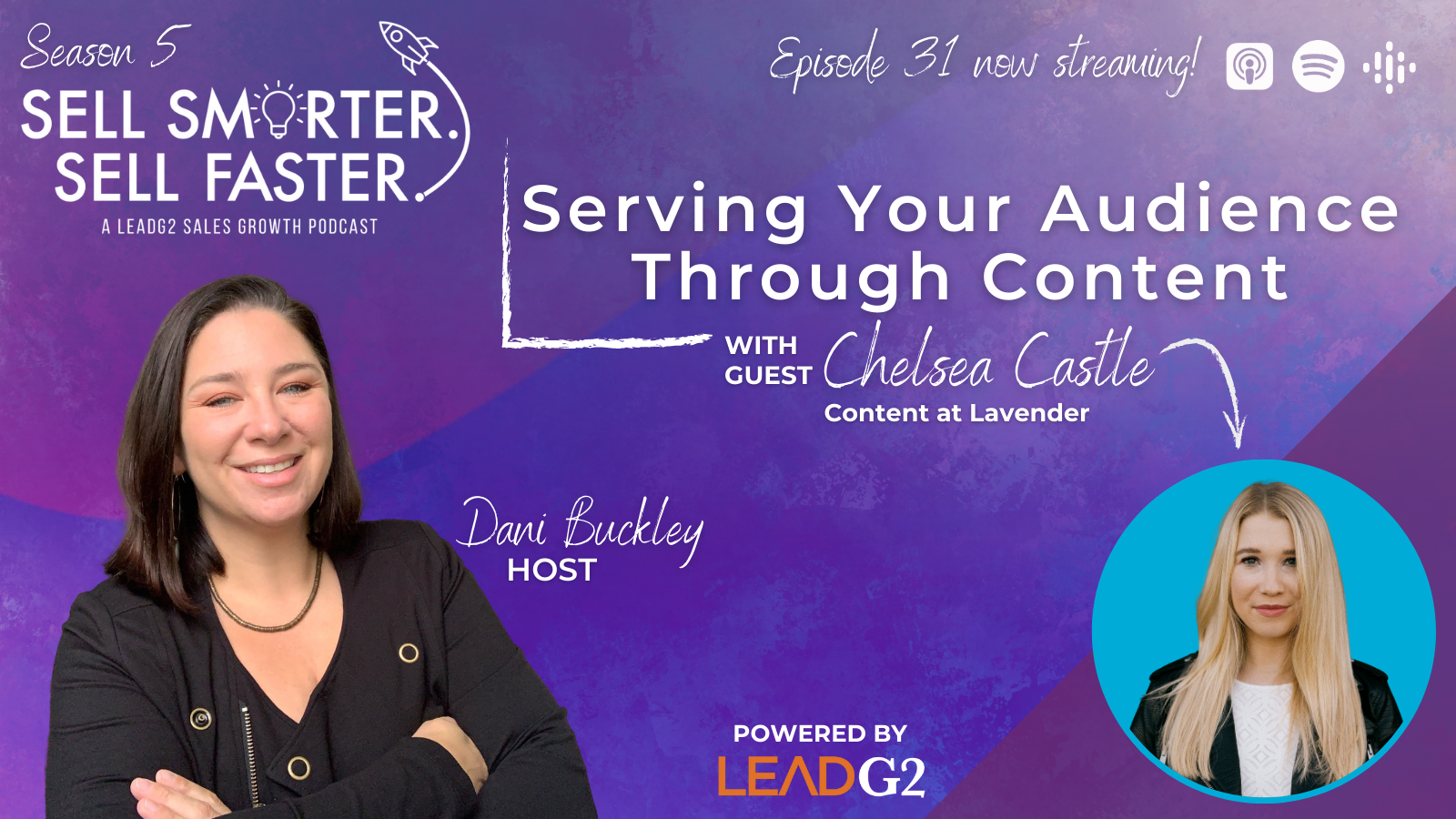Understanding the Differences (And Similarities) Between Sales Enablement and Marketing Content
Marketing content and sales enablement are buzzwords you have probably heard in the B2B world. Over the past several years, content marketing has...


In this episode, we’re exploring the crucial role content plays in truly serving your audience, asking questions like: What makes a piece of content truly valuable? What are the pros and cons of utilizing AI in content creation? And how can business leaders, sellers, and marketers stay current on the latest content creation trends?
Joining Dani to answer those questions and more is the fabulous Chelsea Castle from Lavender.
Chelsea shares a ton of great insights, like:
How can you create content that passes the “eyebrow test?”
Why AI is an assistant and not a replacement for all your content creation needs.
And, finally, how every piece of content you create should come from a place of genuinely wanting to be as helpful as possible to your audience.

“In your opinion, what makes a piece of content truly valuable to an audience?” Dani asks at the top of the conversation. “I know that's a pretty broad question, but tell us about that. And if you can even define ‘content’ in this context...what are we talking about here?
“Yeah, I think that's really important,” Chelsea says. “I'm glad you mentioned that because content today, of course, can refer to so many different content types. It can refer to social media posts and written content, etc.
“For this question and for most of this conversation, I'll be referring to what I think is the more traditional use of the word, which is written content, right? So, articles, but also like any form of written content you might see on a website.
“I guess I'll say, I love any question where I can answer it with, ‘it depends,’ and I think this is one of those.
“For me, when I think about viable content, it depends on the audience, and it depends on the brand. I think what a marketer might find valuable in a piece of content is going to be different than maybe what a software engineer finds valuable in a piece of content.
“At the crux of it though, it needs to be helpful.
“The reader needs to walk away from consuming your piece of content saying, ‘Okay, I learned something new,’ or ‘this made me think differently,’ or ‘Now I have a tool or a template that I can apply to my actual job today in my day-to-day, and it’s helpful.’
“I think a lot of content today can either be fluffy or duplicative or very...like, there's a sea of sameness in B2B right now. It can be boring; it doesn't offer anything new.
“I also like the eyebrow test. [Meaning], does a piece of content make you raise your eyebrow in either a curious way or an ‘I kind of disagree with that’ kind of way, or an ‘I learned something new’ way. It should just evoke something.
“But really, it should be helpful and be something that's not just fluffy.”
“I appreciate that,” Dani says. “Because, especially when people are trying to write SEO, that's the first thing they're thinking of. They completely forget, ‘Is this actually of value to the end user?’
“And that could really hurt your efforts. Maybe you drove traffic there, but then what do they think about you and this piece of content and your brand if it's really fluff and not of any value?”
“Yeah,” Chelsea says. “And so often I think we forget, no matter what your role is, whether you're a salesperson, a marketer, et cetera, that there's a human on the other end of it, right?
“That's something I say all the time is, ‘There's a human on the other end of this email or this article.’ Why are you asking for their time? And what are you actually trying to do?
“If you're trying to provide value with your content, just remember that there's a human on the other end, and what would you want to see when you're creating it as well.”
“So, let's talk about measuring the success of content,” Dani says. “How do you recommend people measure success? Let's focus on blogs and articles, right? I think that's a good place to start. Like how do we measure success for that, and how do you make data-based decisions?”
Chelsea says, “When it comes to measuring success, I like to group things in two buckets: qualitative and quantitative."
“For qualitative, I care a lot about the comments that we receive on posts where where we're sharing the blog. Or I might create a Twitter thread to promote the blog, and I care about how people are responding to it and engaging with it.
“I think that qualitative feedback is definitely underrated."
“That's a big one that I put a lot of focus on. I think it's really important to see what people are saying about it in communities, what you're hearing from customer success and your sales team, who should be using your content and using those blogs. All of that feedback is really important."
“For quantitative, there's the passive or vanity metrics, and then there's the more active or bottom-line metrics."
“I care, obviously, about referral traffic and page views and time on page and session duration and bounce rate. Although, that is all with a bit of grain salt, especially with Google Analytics Four these days."
“And then I'm also looking at distribution channels and that referral traffic rate. I think that's something that isn't looked at enough."
“Then there's contract distribution, which is where things get a little muddy. So, what is it actually doing for pipeline and revenue? And it's tricky, but there definitely are ways to get at how content is influencing pipeline and closed-won revenue. We've definitely found some ways to do that in the past."
“And I say ‘influence’ because the content is most often not going to be first touch or last touch. It's kind of like a whole journey experience. And it's really nice that I've pretty much always had a CEO and marketing team that understands that and is kind of marching toward the right metrics."
“So, that qualitative and quantitative bucket breakdown is really helpful in my experience.”
“I love that,” Dani says. “And just to like break it down even further for folks, I love that you mentioned attribution reporting. Because, I like to make it really clear, for people listening, what we're talking about.
“Let's say you close the deal, you closed a new client, a new customer, and how valuable would it be to be able to see if there was content, if there was marketing and all kinds of attribution that actually contributed to this sale, right?
“So, of course, the salesperson did what they needed to do from ‘this’ point on, but did this prospect before they even talked to sales, did they maybe read a couple of articles? What articles impacted them? Did they maybe download something? Were they on certain pages of your website?
“Those types of things are going to help you, right? [They can help] make better data-based decisions on what content is playing a role in actually closing new business.”
“100%,” Chelsea says. “All those things are signals. And I think especially the qualitative feedback. I don't think I dug deeper there; they're all signals, right? They tell you what's working, and what's not working.
“And especially when a lot of those comments, qualitatively, are coming from actual prospects, you might get people who are engaging with it who aren't necessarily your ICP. But if those people are really engaging with it and letting you know, even if it's just a few people, that's such a valuable signal that you're doing something right and it's resonating with your core audience.
“You have all this data, the qualitative, the quantitative, however, you want to break it down. You take and measure that against your business KPIs and your goals. It's a decision-making puzzle. And I think data is a big piece of that puzzle, but it's not the only piece.
“So when I think about smart decision making, especially in 2023 with the state of the world and the state of technology right now, data's a big piece of it, but you also have to take into consideration like business goals and values and beliefs and your expertise and the experience that you and other people on the team bring to the table.
“I think a lot of times we get caught up in making data-driven decisions, but it's just a piece of it, right? It should be omni-directional and not the one indicator of a decision. There should always be other considerations because data is never going to tell you the whole story.”
“We cannot talk about content and not talk about AI right now,” Dani says. “There are more and more sophisticated tools [arriving] every minute, and ChatGPT, obviously, kind of launched us all into this space, and now there's no turning back.
“It’s exciting and there are pros and cons, of course. So, I'm curious, as of right now...I’m not sure exactly when this episode will air, but let's say around April of 2023, what do you see as the pros and cons of using AI in content creation? Are there any specific ways that you recommend people use it or don’t use it within the foreseeable future? What are your, what are your thoughts?
“Yeah, I have a lot of thoughts,” Chelsea says. “Especially working for an AI company. And I'll say, I'm not an AI expert. I'm still learning as most of us are. But it's a really exciting time. And I think, especially this week when we're recording, GPT Four was just announced by OpenAI, and it's a really exciting thing...in terms of how OpenAI is really dedicated to harnessing this technology and machine learning for humanity.
“I’m still kind of wrapping my head around what that means, but in our day-to-day life, when we're thinking about our work and content specifically, there are definitely pros and cons.
“I think it's an assistant, or it's a tool, or it's a shortcut. It's not going be a replacement; it's not going to be perfect.
“One of my favorite use cases is thinking of it as like a research assistant.
“A lot of people are going to ChatGPT, plugging in prompts, and asking for the machine to generate an exact copy to use for an email or an exact copy to use for X. And I think that's a misuse of the tool, honestly.
“Because it's going to generate something that...if you plug that into our tool Lavender, it's going to score pretty low, and it's not going to get a good reply rate. And it sounds like a robot; it doesn't sound like a human.
“But it can really synthesize content. So, you can plug in a whole bunch of links to articles or videos. And you can ask it to read and analyze and understand these videos and summarize them for you. And then you can go take and use that research to write your article and it's going to save you so much time. It's a shortcut.
“It's definitely not factually accurate sometimes. I say, ‘Trust but verify.’ That’s actually something that our CEO William Ballance says a lot. Because that's how he uses it and it's kind of inspired me to use it in that same way.
“But, again, it's just not going to be a replacement. It's meant to be a tool to help us and not just replace writing your article or writing your sales email or whatever that might be. It's really powerful when used correctly.”
Dani says, “I'm going to say it again, ‘trust but verify.’ So good. I feel like that that reflects our approach at LeadG2 and The Center for Sales Strategy. I'm totally going to share that with my team and use that one.”
Dani says, “One question that comes up a lot is...folks that have a good content strategy for their brand, and they’re staying the course. They put all this work into researching their target persona, and they have their content calendar and all this stuff. And then it's like, ‘okay, is it working? Is it not? Is it working good enough?’
“A lot of these questions come up, and what it leads to is the question often of, ‘do we need to adjust?’ What are maybe some signs someone can look for that they need to maybe pivot?”
“One is trends, right?” Chelsea says. “Monitoring the conversations that are happening with your sales team.
“So, I'm just thinking like a marketer. Maybe you're hearing a lot of things coming up, a lot of objections that keep popping up, that you're not addressing in your content, and you need to know, ‘Okay, I need to pause this one now. I have this entire month of content on my calendar, but there's a lot of things that are coming up for my sales team that they're seeing in the market, and we need to respond to that.’
“I think that's really important. You really need to be in lockstep with your sales team because they're the ears on the ground, knowing what needs to what the needs of your audience are.
“Then I think it’s like, ‘what's working, what's not working?’ Kind of getting to what we were saying earlier, [for example], if you're putting out all this work and you're not seeing a lot in qualitative responses, you're not seeing a lot of like engagement, you're not getting any signals that the work you're doing is resonating. Or then, [on the other hand], maybe it's getting like decent page views, but are page views going up?
“Content is a long-term game. When you're looking at your metrics holistically, there should be an upward movement for sure. You might have some dips, of course, especially seasonally, but there should always be upward movement. So, if that's not happening or maybe it's happening with page views, but maybe session duration and time on page is low, those are signals that you might want to pivot and do things differently.
“I think also B2B is changing so much that I think it's okay to not always stay your course as long as you have intention in buying on your strategy.
“I've definitely been in scenarios where strategy changes so much month to month, and there's whiplash, and then you're never going to know what works if you change too much.
“So, you might also be in a scenario where you're getting pushback to change from leadership, but you're like, ‘Eell, wait a second. We don't know what works yet because we haven't done it long enough.’ I think that's important too.”
“I'm glad you mentioned that,” Dani says. “Because it is a fine balance, right? It's like sticking to the strategy that you are committed to, but also knowing when to make tweaks and pivot but give yourself a chance.
“I always like to ask a question like this,” Dani says. “What is one piece of advice you really want business leaders, content strategists, or marketers to walk away with today that you think will help them?”
“I love this question,” Chelsea says. “So, I have two things. I say, conviction and serving your audience. Those are the two biggest content principles for me personally.
“I think for serving your audience; I would encourage people to think about what that means for you. It might mean something different as a content marketer and also for your business. Everything that you do should be about your audience and your users, and your customers. When you do that, and you do that authentically, when everything you're doing and creating is serving them and being helpful to them, there's an element of reciprocity, of giving and not expecting anything in return and just being helpful through content.
“I've always seen that just kind of come back in spades."
“Then around conviction, the brands that are really winning today have strong conviction in what they will and won't do.
“That's one of the reasons why I joined Lavender. It's been a co-founder and content-led business. Them, as well as a lot of other brands today, I'll call out SparkToro as an example, they have a really strong conviction in how they do things and how they don't want to do things.
“And I think you're starting to see that in more and more brands today, especially in our space. That is definitely one thing that I would offer up as a piece of advice. With your strategy in mind, keep sticking with that conviction and using that as your North Star.
That'll be a big competitive advantage today.”
%20Between%20Sales%20Enablement%20and%20Marketing%20Content%20.png)
Marketing content and sales enablement are buzzwords you have probably heard in the B2B world. Over the past several years, content marketing has...

In the constantly evolving landscape of sales and marketing, content stands as the cornerstone of success. The quality of content plays a pivotal...

There are a number of best practices when it comes to creating graphic content. In this post, let’s take a look at some ways to make or your graphic...